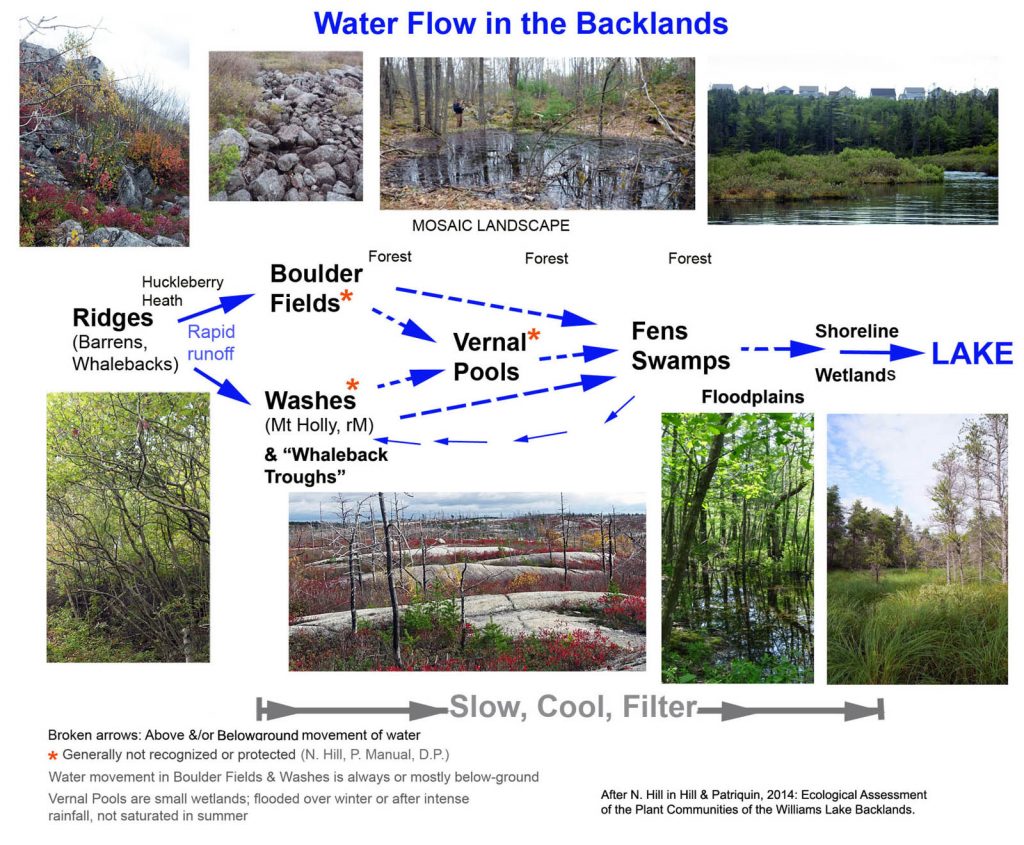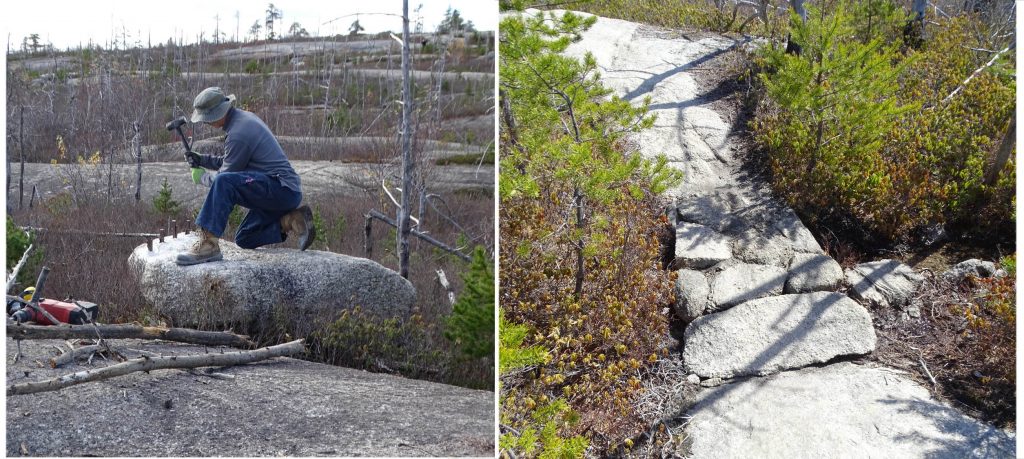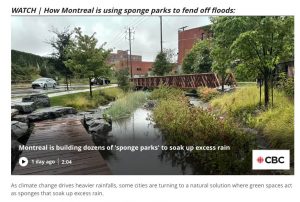
. Screen capture of image in CBC story
Click on images for larger versions
On Nov 2, 2023, I happened to view a CBC TV News item item about “Montreal… building dozens of ‘sponge parks’ to soak up excess rain
I was struck by one scene in particular, of a linear sponge park alongside a paved street (see image at right) – it could almost have been taken on the “Whaleback Barrens” in the Backlands, where wetlands/watercourses occur in the troughs or gullies between the whalebacks.
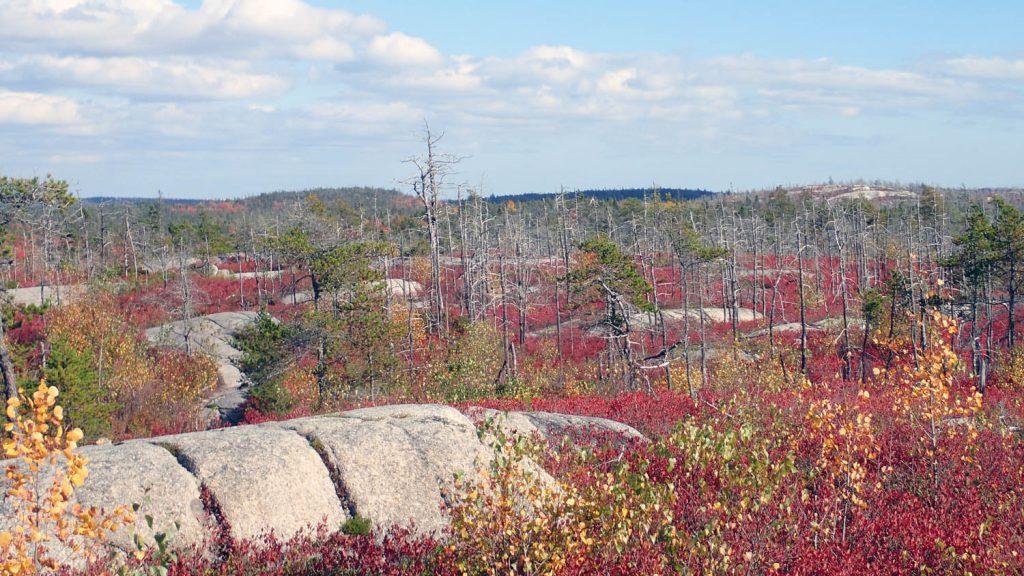
The “Whaleback Barrens” by the Governor’s Brook residential area on Oct 17, 2016. In the foreground just behind the closest whaleback outcrop are old Jack Pine trees that escaped the 2009 “Spryfield Fire”. The dead trees beyond are those of Jack Pine (mostly) that burned in that fire. The red is huckleberry leaves. The rock outcrops are described geologically as ‘whalebacks’; there is a “field of whalebacks” in this area. The deeper areas within the troughs between the whalebacks are wetlands/watercourses.
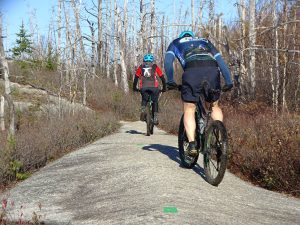 The whalebacks are hard surfaces equivalent to paved streets, and provide a similar services – in the case of the barrens, mountain biking and walking. Runoff from the exposed whaleback surfaces occurs very rapidly, as it does on paved streets.
The whalebacks are hard surfaces equivalent to paved streets, and provide a similar services – in the case of the barrens, mountain biking and walking. Runoff from the exposed whaleback surfaces occurs very rapidly, as it does on paved streets.
A range of wetland sizes and types are employed in “Sponge Cities” and likewise a range of wetland types and sizes occur on the barrens landscape; even under the heaviest rainfalls of this past summer, it did not flood or become impassable – a goal of Sponge Cities.
Surely our Whaleback Barrens would be a great place to conduct a study of how density, size, and composition of wetlands. seasonality, fire etc., and lichen and other cover on the whalebacks affect water flows over the short and long term. Such a study could be very relevant to efforts to create Sponge Cities AND help us to better understand functioning of wetlands in Nova Scotia – especially small wetlands, most of which have no protection.
- David P
Some Links
‘Sponge cities’: An absorbing idea in the face of climate change
Benjamin Shingler · CBC News Nov 4, 2023. “From China to Montreal, urban planners are using nature to solve problem of flooding”
What are ‘sponge cities’ and how can they prevent floods?
By Kim Harrisberg in Climate Champions, Apr 11, 2022
Utilization of constructed wetland technology in China’s sponge city scheme under carbon neutral vision
Yamei Cai et al. 2023. In Journal of Water Process Engineering. “Constructed wetlands (CWs) can not only purify water quality, but also store and regulate rainwater in “Sponge City” scheme, which is a national strategy in China… By comparing the “6-character policy” of sponge city technology measures with the basic characteristics of CWs as well as the carbon emission reduction of CWs and sponge city facilities, the different roles of CWs combinations in sponge city construction were given.” Good Overview of the Sponge City concept and technologies, developed initially in China.
Watersheds, Watercourses and Wetlands of the Halifax Backlands
Webinar presentation by David Patriquin on Aug 15, 2023 with Q&As. For Ecology Action Centre and Nature Nova Scotia Lunch & Learn: Wetlands, Adaptations and Extreme Weather Events.
– YouTube Video
– Slides for the presentation (29 slides, 18 MB)
– Summary(Text)
Osprey Trail: pine barrens & whalebacks
Page on this website
Water flow on the Whaleback Barrens (Halifax NS) Oct 31, 2023
YouTube Video by David P illustrates flow of water through wetlands/watercourse on the Whaleback Barrens after a day of rain.
McIntosh Run Watershed Association
The MWRA built and maintains a singletrack trail system on the Whaleback Barrens “to provide a sustainable wilderness experience to trail users…with the aim of understanding and appreciating this diverse and beautiful landscape.”


